Examining Urban Impervious Surface Distribution and Its Dynamic Change in Hangzhou Metropolis
Abstract
:1. Introduction
2. Study Area
3. Methods
3.1. Data Collection and Preprocessing
3.2. Mapping ISA Distribution
3.3. Spatiotemporal Analysis of ISA Distribution and Its Dynamic Change
3.3.1. Analysis of Spatial Patterns of ISA Distribution and Its Dynamic Change at Pixel Level and Administrative Unit Scale
3.3.2. Analysis of Spatial Patterns of ISA Distribution and Its Dynamic Change Using the Buffer Zone-Based Approach in Different Directions
3.4. Impacts of Topography on Urban ISA Distribution and Dynamic Change
4. Results
4.1. Analysis of ISA Distribution and Its Dynamic Change at Pixel Scale
4.2. Analysis of ISA Distribution and Its Dynamic Change at Administrative Units
4.3. Analysis of ISA Distribution at Buffer Zone Scale in Different Directions
4.4. Analysis of ISA Dynamic Change at Buffer Zone Scale in Different Directions
4.5. Analysis of Topographic Impacts on Urban Expansion
5. Discussion
5.1. Improvement of ISA Mapping Performance
5.2. Examination of ISA Expansion and Roles of the Buffer Zone–Based Approach
5.3. Effects of Topographic Factors and Policies on Urban Expansion Patterns
6. Conclusions
- (1)
- The hybrid approach can effectively extract ISA distribution with an overall accuracy of over 95%, and both producer and user accuracies of over 91%. This approach provided the fundamental data sources for examining urban dynamic change over time.
- (2)
- ISA in Hangzhou metropolis increased from 146 km2 in 1991 to 868 km2 in 2014. Annual ISA growth rates were between 15.6 km2/year and 48.8 km2/year with the lowest growth rate in 1994–2000 and the highest growth rate in 2005–2010.
- (3)
- Urban expansion has various rates and patterns at different distances from the urban center in various directions between 1991 and 2014. Topographic factors, especially slope, are important constraints influencing spatial patterns of urban distribution and expansion.
- (4)
- Policies may be important factors influencing urbanization patterns and rates, but they are difficult to quantify.
Acknowledgments
Author Contributions
Conflicts of Interest
References
- Yin, J.; Yin, Z.; Zhong, H.; Xu, S.; Hu, X.; Wang, J.; Wu, J. Monitoring urban expansion and land use/land cover changes of Shanghai metropolitan area during the transitional economy (1979–2009) in China. Environ. Monit. Assess. 2011, 177, 609–621. [Google Scholar] [CrossRef] [PubMed]
- Liu, Z.; He, C.; Zhang, Q.; Huang, Q.; Yang, Y. Extracting the dynamics of urban expansion in China using DMSP-OLS nighttime light data from 1992 to 2008. Landsc. Urban Plan. 2012, 106, 62–72. [Google Scholar] [CrossRef]
- Schneider, A. Monitoring land cover change in urban and peri-urban areas using dense time stacks of Landsat satellite data and a data mining approach. Remote Sens. Environ. 2012, 124, 689–704. [Google Scholar] [CrossRef]
- Wang, L.; Li, C.; Ying, Q.; Cheng, X.; Wang, X.; Li, X.; Hu, L.; Liang, L.; Yu, L.; Huang, H.; et al. China’s urban expansion from 1990 to 2010 determined with satellite remote sensing. Chin. Sci. Bull. 2012, 57, 2802–2812. [Google Scholar] [CrossRef]
- Schneider, A.; Chang, C.; Paulsen, K. The changing spatial form of cities in Western China. Landsc. Urban Plan. 2015, 135, 40–61. [Google Scholar] [CrossRef]
- He, C.; Liu, Z.; Tian, J.; Ma, Q. Urban expansion dynamics and natural habitat loss in China: A multiscale landscape perspective. Glob. Chang. Biol. 2014, 20, 2886–2902. [Google Scholar] [CrossRef] [PubMed]
- Srinivasan, V.; Seto, K.C.; Emerson, R.; Gorelick, S.M. The impact of urbanization on water vulnerability: A coupled human–environment system approach for Chennai, India. Glob. Environ. Chang. 2013, 23, 229–239. [Google Scholar] [CrossRef]
- Schneider, A.; Mertes, C.M. Expansion and growth in Chinese cities, 1978–2010. Environ. Res. Lett. 2014, 9. [Google Scholar] [CrossRef]
- Yuan, F.; Bauer, M.E. Comparison of impervious surface area and normalized difference vegetation index as indicators of surface urban heat island effects in Landsat imagery. Remote Sens. Environ. 2007, 106, 375–386. [Google Scholar] [CrossRef]
- Myint, S.W.; Zheng, B.; Talen, E.; Fan, C.; Kaplan, S.; Middel, A.; Smith, M.; Huang, H.; Brazel, A. Does the spatial arrangement of urban landscape matter? Examples of urban warming and cooling in Phoenix and Las Vegas. Ecosyst. Health Sustain. 2015, 1. [Google Scholar] [CrossRef]
- Xu, H.; Lin, D.; Tang, F. The impact of impervious surface development on land surface temperature in a subtropical city: Xiamen, China. Int. J. Climatol. 2013, 33, 1873–1883. [Google Scholar] [CrossRef]
- Xian, G. Satellite remotely-sensed land surface parameters and their climatic effects for three metropolitan regions. Adv. Space Res. 2008, 41, 1861–1869. [Google Scholar] [CrossRef]
- Wu, J.; He, C.; Huang, G.; Yu, D. Urban Landscape Ecology: Past, Present, and Future. In Landscape Ecology for Sustainable Environment and Culture; Fu, B., Jones, K.B., Eds.; Springer Science & Business Media: Dordrecht, The Netherlands, 2013; Chapter 3; pp. 37–53. [Google Scholar]
- Fan, P.; Xie, Y.; Qi, J.; Chen, J.; Huang, H. Vulnerability of a coupled natural and human system in a changing environment: Dynamics of Lanzhou’s urban landscape. Landsc. Ecol. 2014, 29, 1709–1723. [Google Scholar] [CrossRef]
- Michishita, R.; Jiang, Z.; Xu, B. Monitoring two decades of urbanization in the Poyang Lake area, China through spectral unmixing. Remote Sens. Environ. 2012, 117, 3–18. [Google Scholar] [CrossRef]
- Zhang, C.; Chen, Y.; Lu, D. Mapping the land-cover distribution in arid and semiarid urban landscapes with Landsat Thematic Mapper imagery. Int. J. Remote Sens. 2015, 36, 4483–4500. [Google Scholar] [CrossRef]
- Zhang, C.; Chen, Y.; Lu, D. Detecting fractional land-cover change in arid and semiarid urban landscapes with multitemporal Landsat Thematic Mapper imagery. GISci. Remote Sens. 2015, 52, 700–722. [Google Scholar] [CrossRef]
- Myint, S.W.; Gober, P.; Brazel, A.; Grossman-Clarke, S.; Weng, Q. Per-pixel versus object-based classification of urban land cover extraction using high spatial resolution imagery. Remote Sens. Environ. 2011, 115, 1145–1161. [Google Scholar] [CrossRef]
- Sexton, J.O.; Song, X.; Huang, C.; Channan, S.; Baker, M.E.; Townshend, J.R. Urban growth of the Washington, D.C.–Baltimore, MD metropolitan region from 1984 to 2010 by annual Landsat-based estimates of impervious cover. Remote Sens. Environ. 2013, 129, 42–53. [Google Scholar] [CrossRef]
- Kuang, W.; Chi, W.; Lu, D.; Dou, Y. A comparative analysis of megacity expansions in China and the U.S.: Patterns, rates and driving forces. Landsc. Urban Plan. 2014, 132, 121–135. [Google Scholar] [CrossRef]
- Lu, D.; Weng, Q. Use of Impervious Surface in Urban Land Use Classification. Remote Sens. Environ. 2006, 102, 146–160. [Google Scholar] [CrossRef]
- Wu, C.; Murray, A.T. Estimating impervious surface distribution by spectral mixture analysis. Remote Sens. Environ. 2003, 84, 493–505. [Google Scholar] [CrossRef]
- Li, X.; Gong, P.; Liang, L. A 30-year (1984–2013) record of annual urban dynamics of Beijing City derived from Landsat data. Remote Sens. Environ. 2015, 166, 78–90. [Google Scholar] [CrossRef]
- Powell, S.; Cohen, W.B.; Yang, Z.; Pierce, J.D.; Alberti, M. Quantification of impervious surface in the Snohomish Water Resources Inventory Area of Western Washington from 1972 to 2006. Remote Sens. Environ. 2008, 112, 1895–1908. [Google Scholar] [CrossRef]
- Lu, D.; Li, G.; Moran, E. Current situation and needs of change detection techniques. Int. J. Image Data Fusion 2014, 5, 13–38. [Google Scholar] [CrossRef]
- Lu, D.; Mausel, P.; Brondízio, E.; Moran, E. Change Detection Techniques. Int. J. Remote Sens. 2004, 25, 2365–2407. [Google Scholar] [CrossRef]
- Bhagat, V.S. Use of remote sensing techniques for robust digital change detection of land: A review. Recent Pat. Space Technol. 2012, 2, 123–144. [Google Scholar] [CrossRef]
- Coppin, P.; Jonckheere, I.; Nackaerts, K.; Muys, B.; Lambin, E. Digital change detection methods in ecosystem monitoring: A review. Int. J. Remote Sens. 2004, 25, 1565–1596. [Google Scholar] [CrossRef]
- Hansen, M.C.; Loveland, T.R. A review of large area monitoring of land cover change using Landsat data. Remote Sens. Environ. 2012, 122, 66–74. [Google Scholar] [CrossRef]
- Im, J.; Jensen, J.R.; Tullis, J.A. Object-based change detection using correlation image analysis and image segmentation. Int. J. Remote Sens. 2008, 29, 399–423. [Google Scholar] [CrossRef]
- Lu, D.; Weng, Q. Spectral Mixture Analysis of the Urban Landscapes in Indianapolis with Landsat ETM+ Imagery. Photogramm. Eng. Remote Sens. 2004, 70, 1053–1062. [Google Scholar] [CrossRef]
- Weng, Q. Remote sensing of impervious surfaces in the urban areas: Requirements, methods, and trends. Remote Sens. Environ. 2012, 117, 34–49. [Google Scholar] [CrossRef]
- Lu, D.; Moran, E.; Hetrick, S. Detection of Impervious Surface Change with Multitemporal Landsat Images in an Urban-rural Frontier. ISPRS J. Photogramm. Remote Sens. 2011, 66, 298–306. [Google Scholar] [CrossRef] [PubMed]
- Lu, D.; Li, G.; Kuang, W.; Moran, E. Methods to extract impervious surface areas from satellite images. Int. J. Digit. Earth 2014, 7, 93–112. [Google Scholar] [CrossRef]
- Weng, Q. Remote Sensing of Impervious Surfaces; CRC Press: Boca Raton, FL, USA, 2007; p. 488. [Google Scholar]
- Guo, W.; Lu, D.; Wu, Y.; Zhang, J. Mapping impervious surface distribution with integration of SNNP VIIRS-DNB and MODIS NDVI data. Remote Sens. 2015, 7, 12459–12477. [Google Scholar] [CrossRef]
- Zhang, H.; Lin, H.; Zhang, Y.; Weng, Q. Remote Sensing of Impervious Surfaces in Tropical and Subtropical Areas; CRC Press: Boca Raton, FL, USA, 2015; p. 174. [Google Scholar]
- Xian, G.; Homer, C. Updating the 2001 National Land Cover Database Impervious Surface Products to 2006 using Landsat Imagery Change Detection Methods. Remote Sens. Environ. 2010, 114, 1676–1686. [Google Scholar] [CrossRef]
- Mountrakis, G.; Li, L. Enhancing and replacing spectral information with intermediate structural inputs: A case study on impervious surface detection. Remote Sens. Environ. 2011, 115, 1162–1170. [Google Scholar] [CrossRef]
- Yang, F.; Matsushita, B.; Fukushima, T.; Yang, W. Temporal mixture analysis for estimating impervious surface area from multi-temporal MODIS NDVI data in Japan. ISPRS J. Photogramm. Remote Sens. 2012, 72, 90–98. [Google Scholar] [CrossRef]
- Weng, Q.; Lu, D.; Schubring, J. Estimation of land surface temperature–vegetation abundance relationship for urban heat island studies. Remote Sens. Environ. 2004, 89, 467–483. [Google Scholar] [CrossRef]
- Bauer, M.E.; Loffelholz, B.C.; Wilson, B. Estimating and mapping impervious surface area by regression analysis of Landsat imagery. In Remote Sensing of Impervious Surfaces; Weng, Q., Ed.; CRC Press: Boca Raton, FL, USA, 2008; pp. 3–19. [Google Scholar]
- Kaspersen, P.S.; Fensholt, R.; Drews, M. Using Landsat Vegetation Indices to Estimate Impervious Surface Fractions for European Cities. Remote Sens. 2015, 7, 8224–8249. [Google Scholar] [CrossRef]
- Ridd, M.K. Exploring a V-I-S (vegetation-impervious surface-soil) model for urban ecosystem analysis through remote sensing: Comparative anatomy for cities. Int. J. Remote Sens. 1995, 16, 2165–2185. [Google Scholar] [CrossRef]
- Weng, Q.; Liu, H.; Lu, D. Assessing the Effects of Land Use and Land Cover Patterns on Thermal Conditions Using Landscape Metrics in City of Indianapolis, United States. Urban Ecosyst. 2007, 10, 203–219. [Google Scholar] [CrossRef]
- Weng, Q.; Lu, D. A Sub-pixel Analysis of Urbanization Effect on Land Surface Temperature and its Interplay with Impervious Surface and Vegetation Coverage in Indianapolis, United States. Int. J. Appl. Earth Obs. Geoinf. 2008, 10, 68–83. [Google Scholar] [CrossRef]
- Fan, C.; Myint, S.W.; Zheng, B. Measuring the spatial arrangement of urban vegetation and its impacts on seasonal surface temperatures. Prog. Phys. Geogr. 2015, 39, 199–219. [Google Scholar] [CrossRef]
- Lu, D.; Hetrick, S.; Moran, E.; Li, G. Detection of urban expansion in an urban-rural landscape with multitemporal QuickBird images. J. Appl. Remote Sens. 2010, 4. [Google Scholar] [CrossRef] [PubMed]
- Hangzhou City Climate Characteristics. Available online: http://www.hangzhou.gov.cn/main/zjhz/hzlj/2007/zsh/T232609.shtml (accessed on 20 May 2015).
- Zhejiang Statistical Bureau. Zhejiang Statistical Yearbook; China Statistics Press: Beijing, China, 2014. (In Chinese)
- Hangzhou City Administrative Division Adjustment. Available online: http://www.people.com.cn/GB/shizheng/19/20010312/415229.html (accessed on 20 May 2015).
- Mustard, J.F.; Sunshine, J.M. Spectral analysis for earth science: Investigations using remote sensing data. Remote Sens. Earth Sci. Man. Remote Sens. 1999, 3, 251–307. [Google Scholar]
- Xu, H. A study on information extraction of water body with the modified normalized difference water index (MNDWI). J. Remote Sens. 2005, 5, 589–595. [Google Scholar]
- Congalton, R.G.; Green, K. Assessing the Accuracy of Remotely Sensed Data: Principles and Practices, 2nd ed.; CRC Press: Boca Raton, FL, USA, 2008. [Google Scholar]
- Lu, D.; Weng, Q. A Survey of Image Classification Methods and Techniques for Improving Classification Performance. Int. J. Remote Sens. 2007, 28, 823–870. [Google Scholar] [CrossRef]
- Lu, D.; Weng, Q. Urban Classification Using Full Spectral Information of Landsat ETM+ Imagery in Marion County, Indiana. Photogramm. Eng. Remote Sens. 2005, 71, 1275–1284. [Google Scholar] [CrossRef]
- Kuang, W.; Liu, J.; Dong, J.; Chi, W.; Zhang, C. The rapid and massive urban and industrial land expansions in China between 1990 and 2010: A CLUD-based analysis of their trajectories, patterns, and drivers. Landsc. Urban Plan. 2016, 145, 21–33. [Google Scholar] [CrossRef]
- Deng, C.; Wu, C. A spatially adaptive spectral mixture analysis for mapping subpixel urban impervious surface distribution. Remote Sens. Environ. 2013, 133, 62–70. [Google Scholar] [CrossRef]
- Lu, D.; Li, G.; Moran, E.; Hetrick, S. Spatiotemporal analysis of land-use and land-cover change in the Brazilian Amazon. Int. J. Remote Sens. 2013, 34, 5953–5978. [Google Scholar] [CrossRef] [PubMed]
- Lu, D.; Tian, H.; Zhou, G.; Ge, H. Regional Mapping of Human Settlements in Southeastern China with Multisensor Remotely Sensed Data. Remote Sens. Environ. 2008, 112, 3668–3679. [Google Scholar] [CrossRef]
- Kuang, W. Evaluating impervious surface growth and its impacts on water environment in Beijing-Tianjin-Tangshan Metropolitan Area. J. Geogr. Sci. 2012, 22, 535–547. [Google Scholar] [CrossRef]
- Kuang, W.; Dou, Y.; Zhang, C.; Chi, W.; Liu, A.; Liu, Y.; Zhang, R.; Liu, J. Quantifying the heat flux regulation of metropolitan land-use/land-cover components by coupling remote sensing-modelling with in situ measurement. J. Geogr. Res. Atmos. 2015, 120, 113–130. [Google Scholar] [CrossRef]
- Kuang, W.; Liu, Y.; Dou, Y.; Chi, W.; Chen, G.; Gao, C.; Yang, T.; Liu, J.; Zhang, R. What are hot and what are not in an urban landscape: Quantifying and explaining the land surface temperature pattern in Beijing, China. Landsc. Ecol. 2015, 30, 357–373. [Google Scholar] [CrossRef]
- Kuang, W.; Liu, J.; Zhang, Z.; Lu, D.; Xiang, B. Spatiotemporal dynamics of impervious surface areas across China during the early 21st century. Chin. Sci. Bull. 2013, 58, 1691–1701. [Google Scholar] [CrossRef]
- Lu, D.; Xu, X.; Tian, H.; Moran, E.; Zhao, M.; Running, S. The effects of urbanization on net primary productivity in Southeastern China. Environ. Manag. 2010, 46, 404–410. [Google Scholar] [CrossRef] [PubMed]
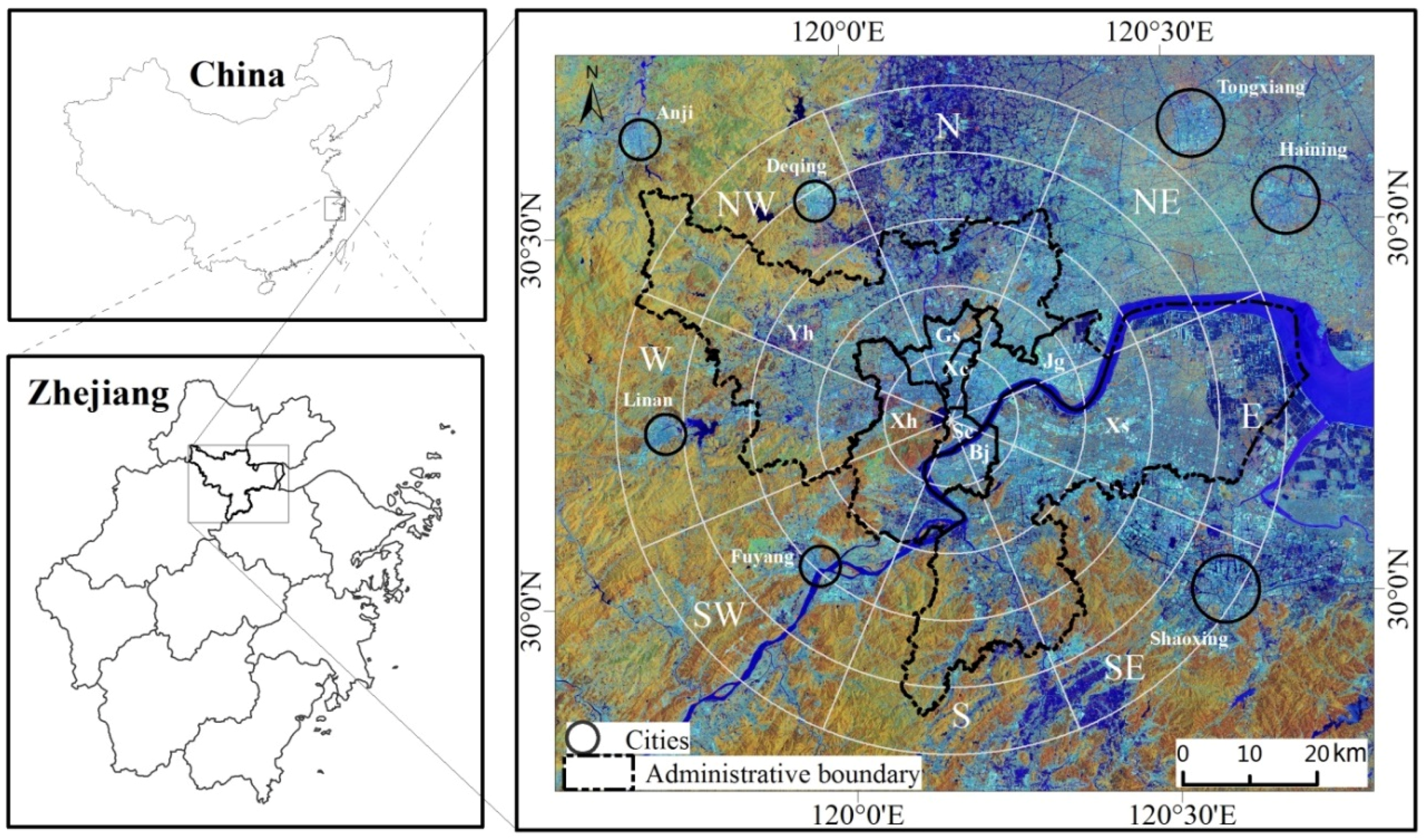
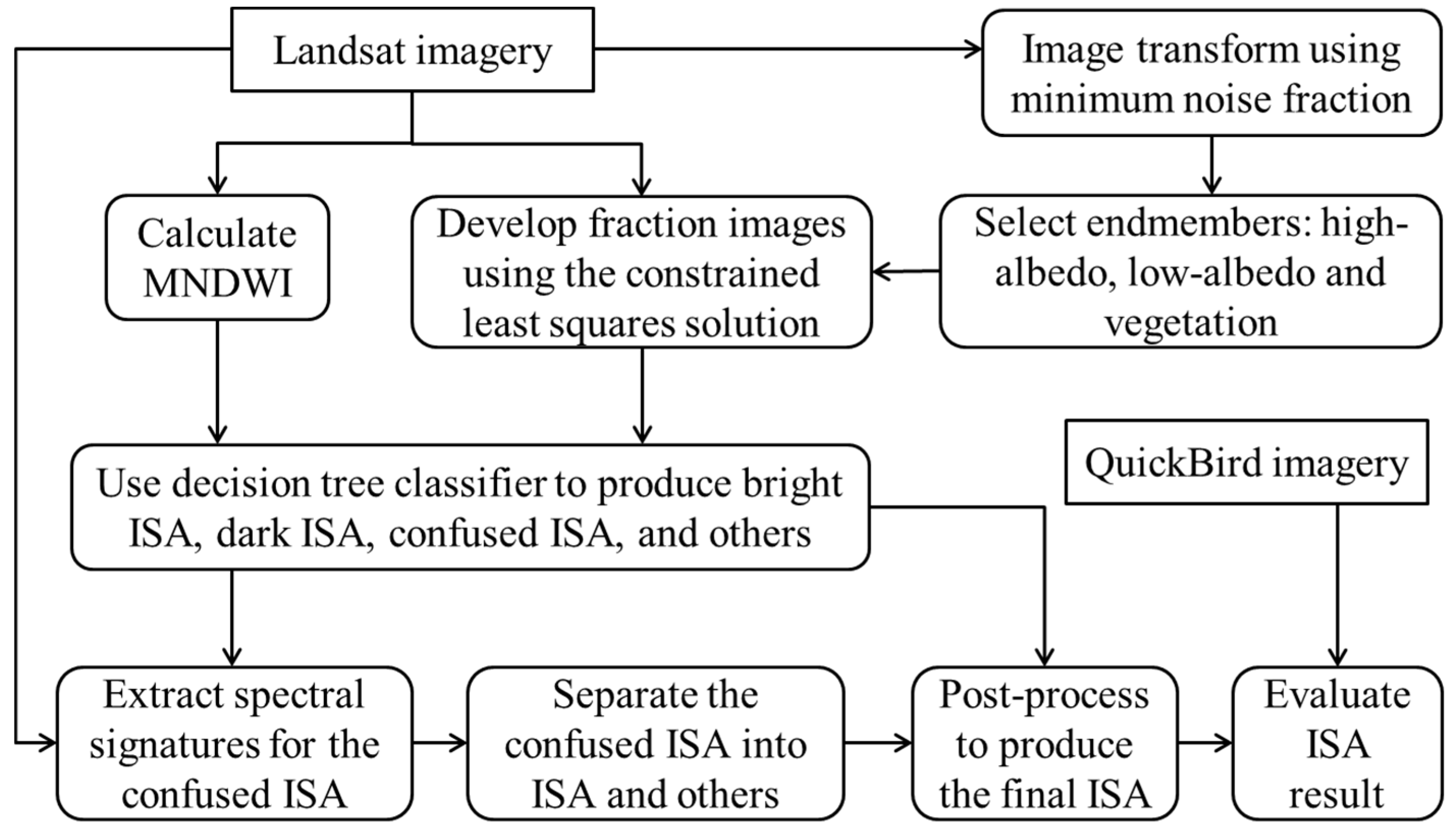
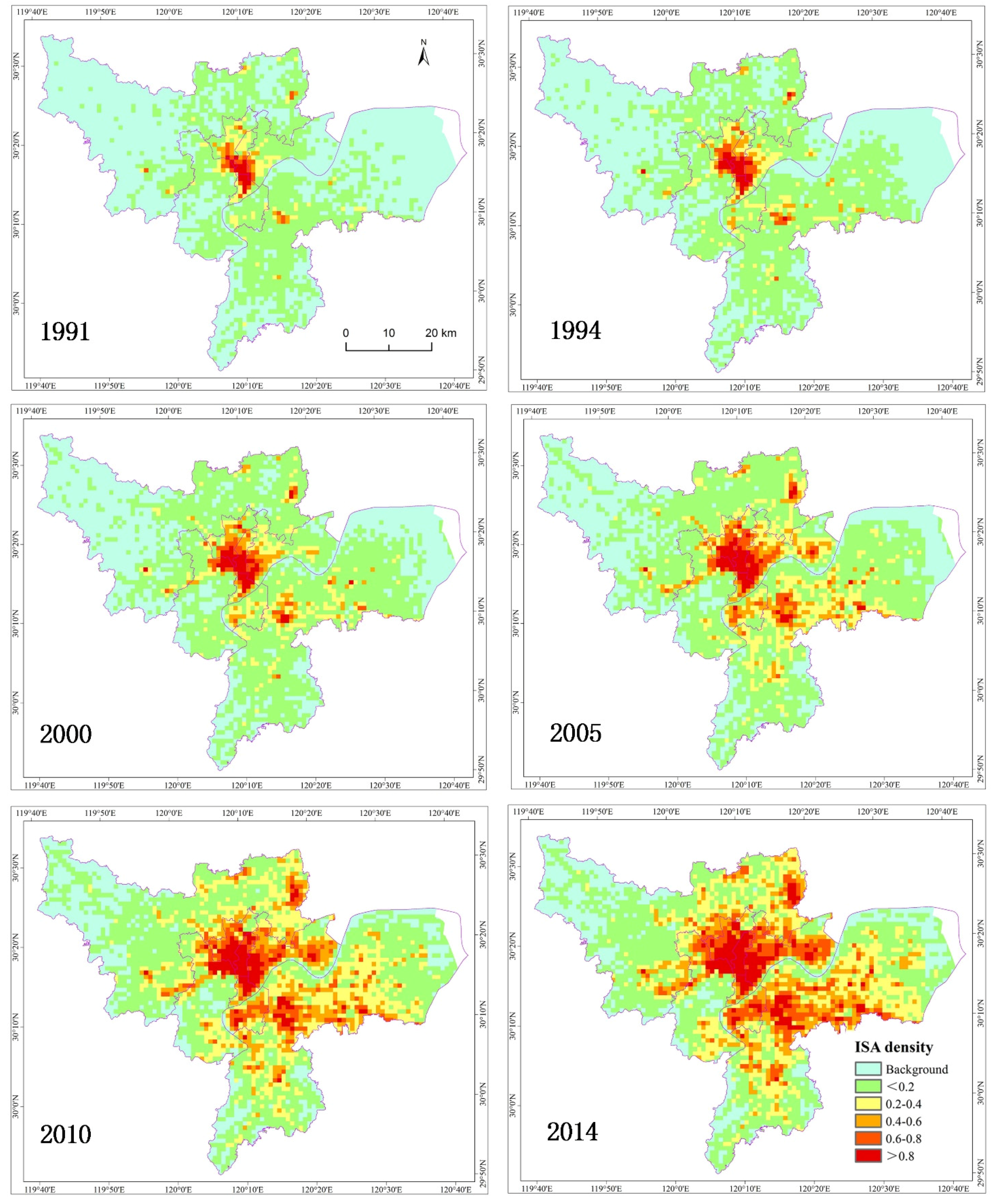

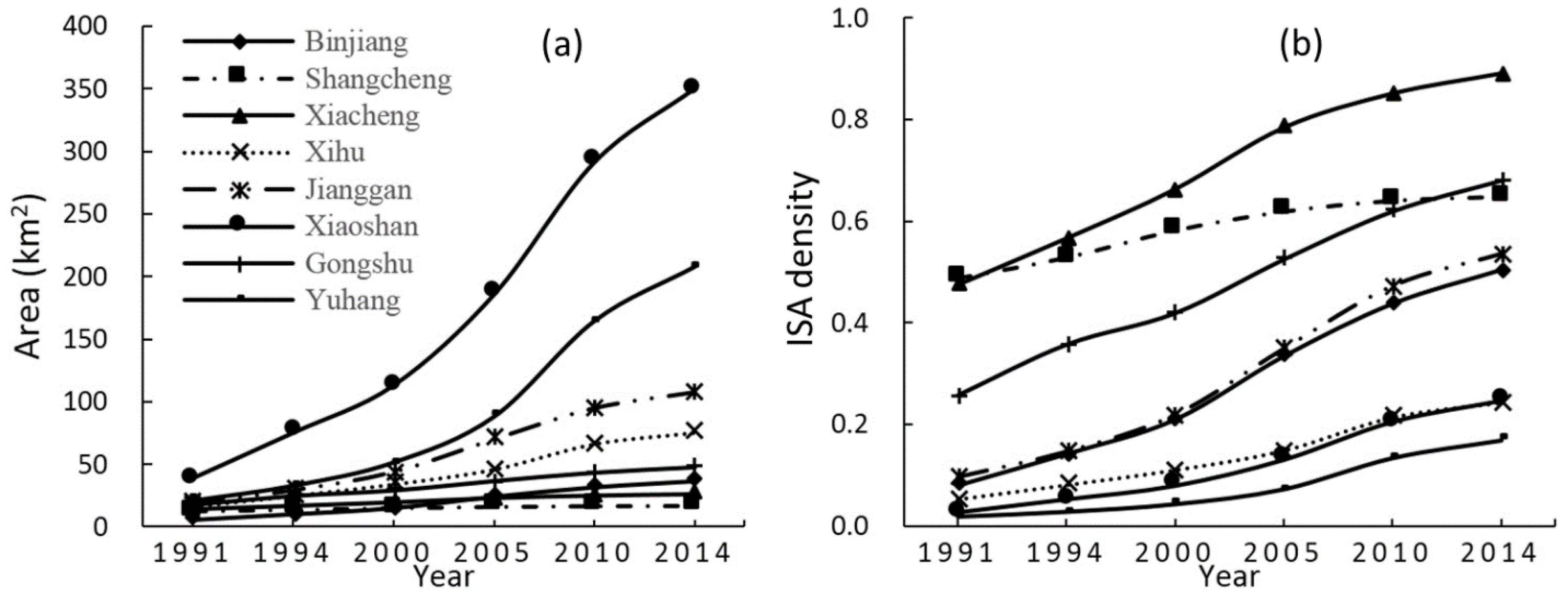
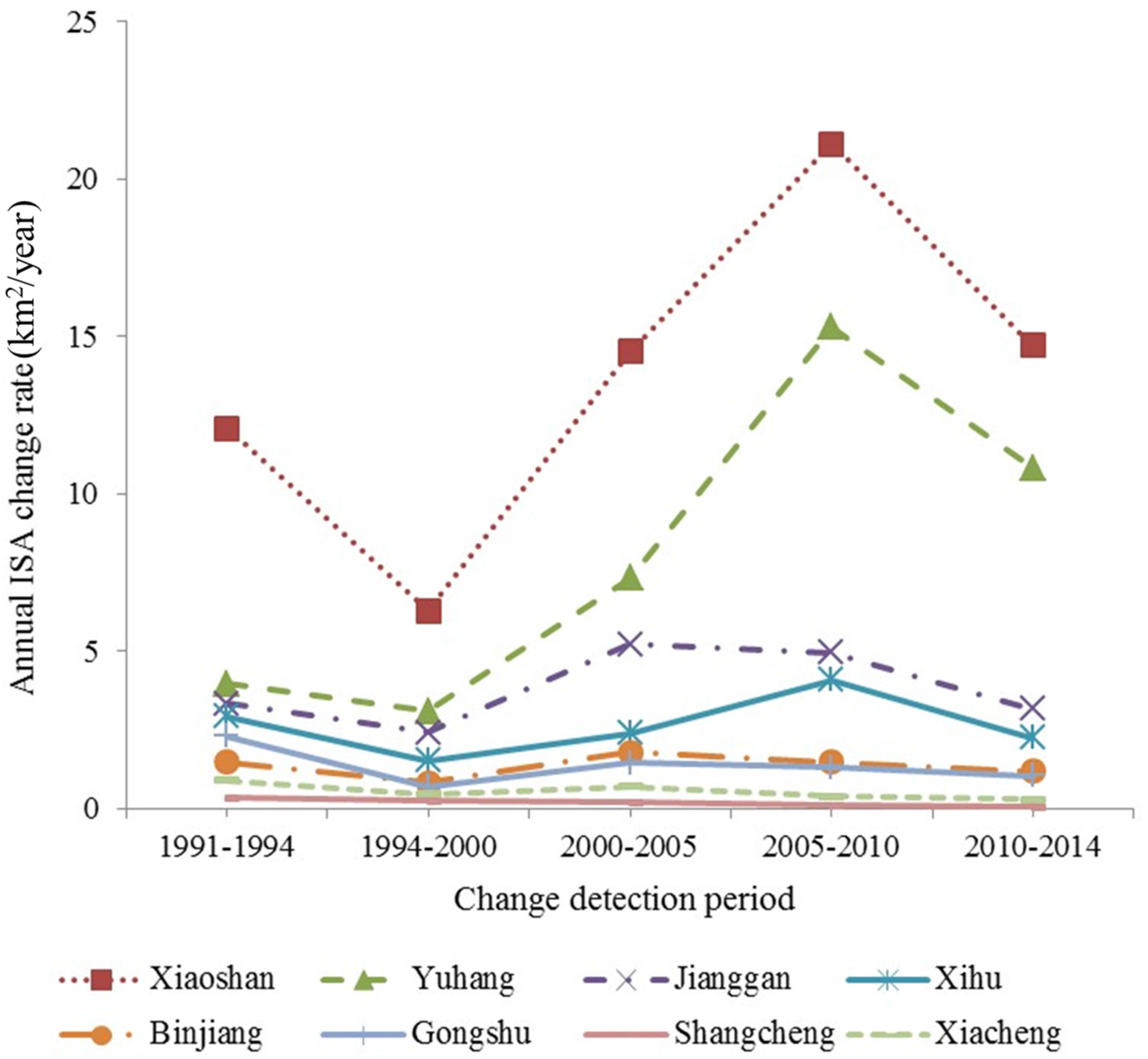
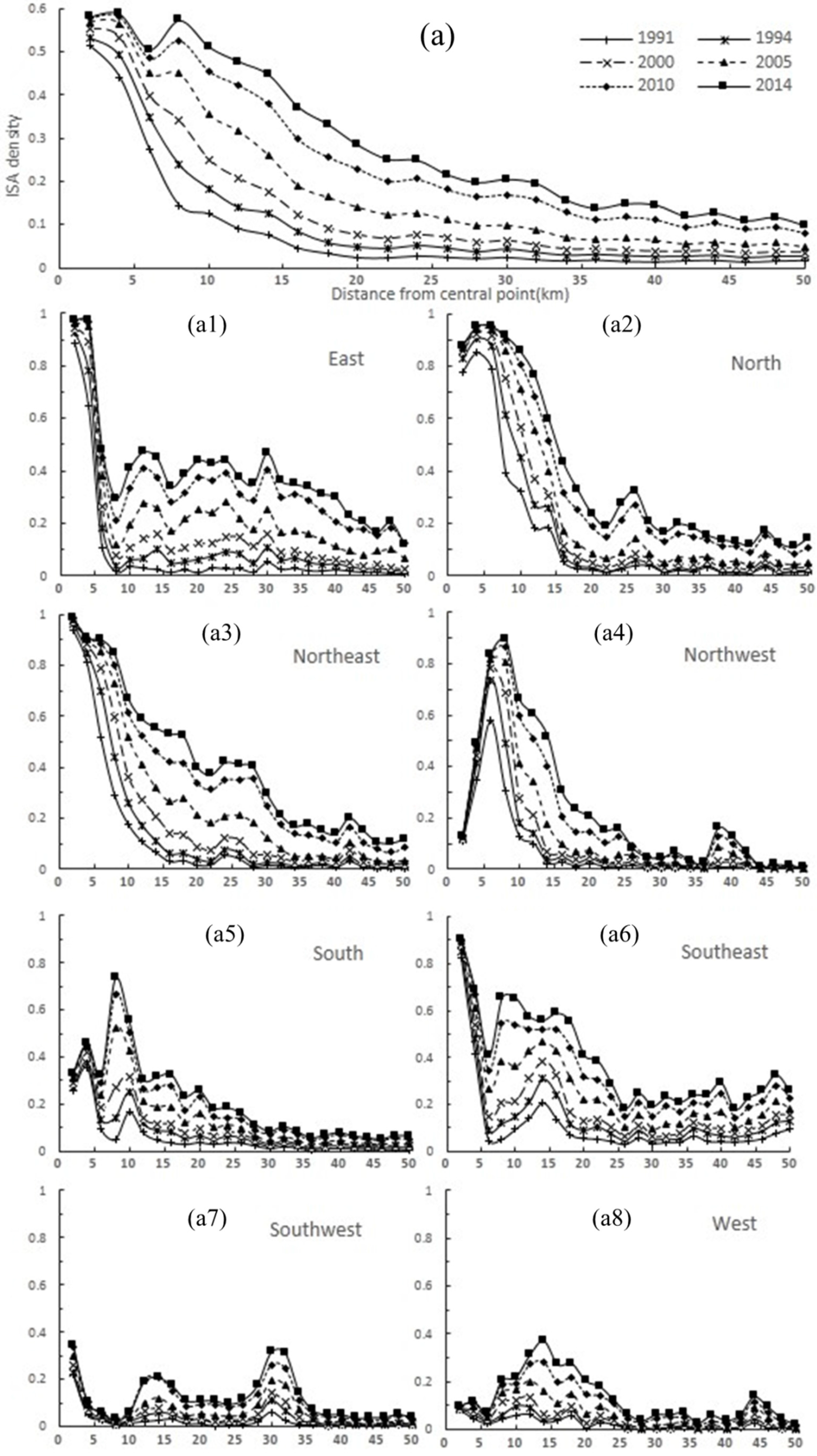
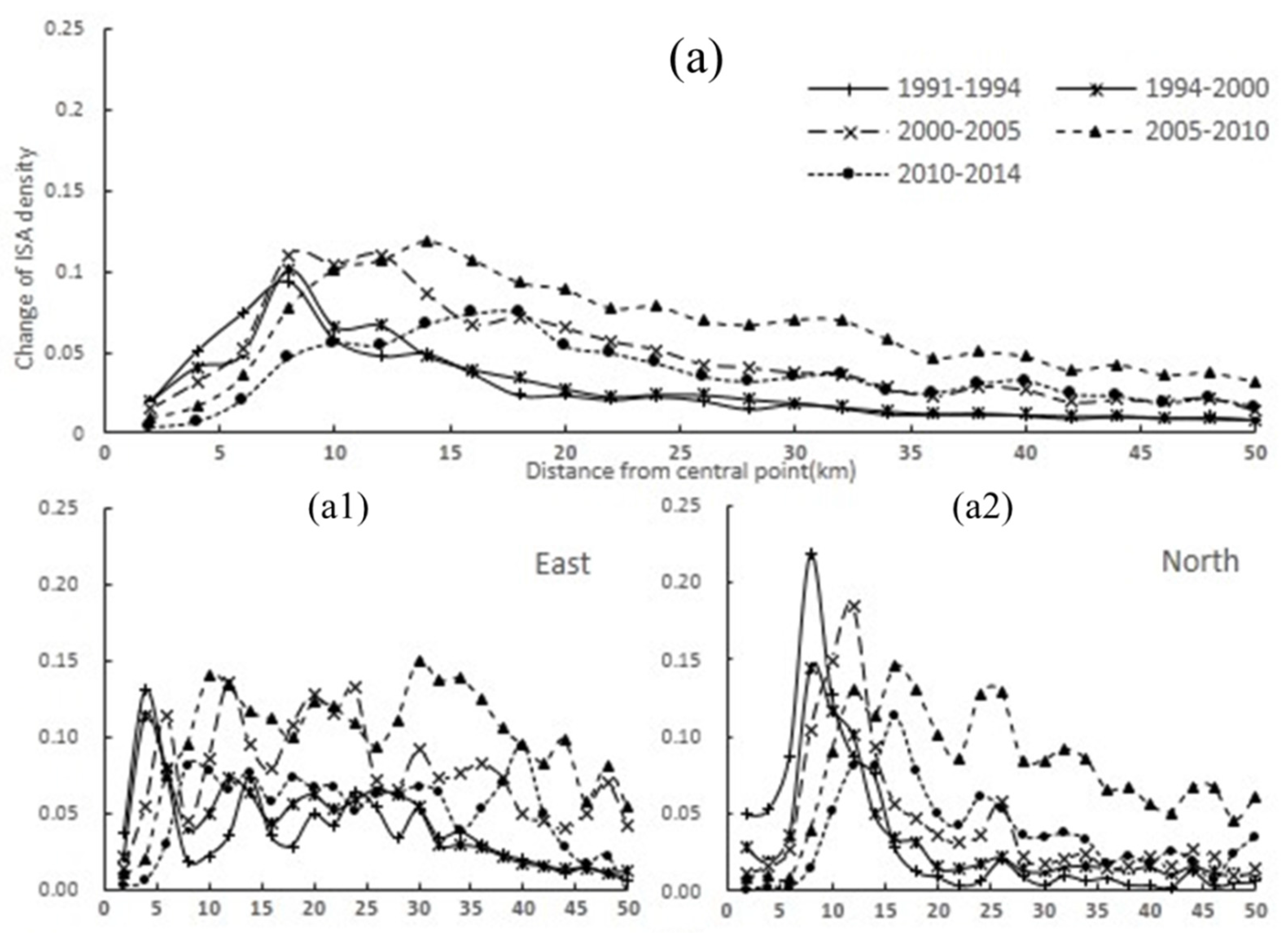
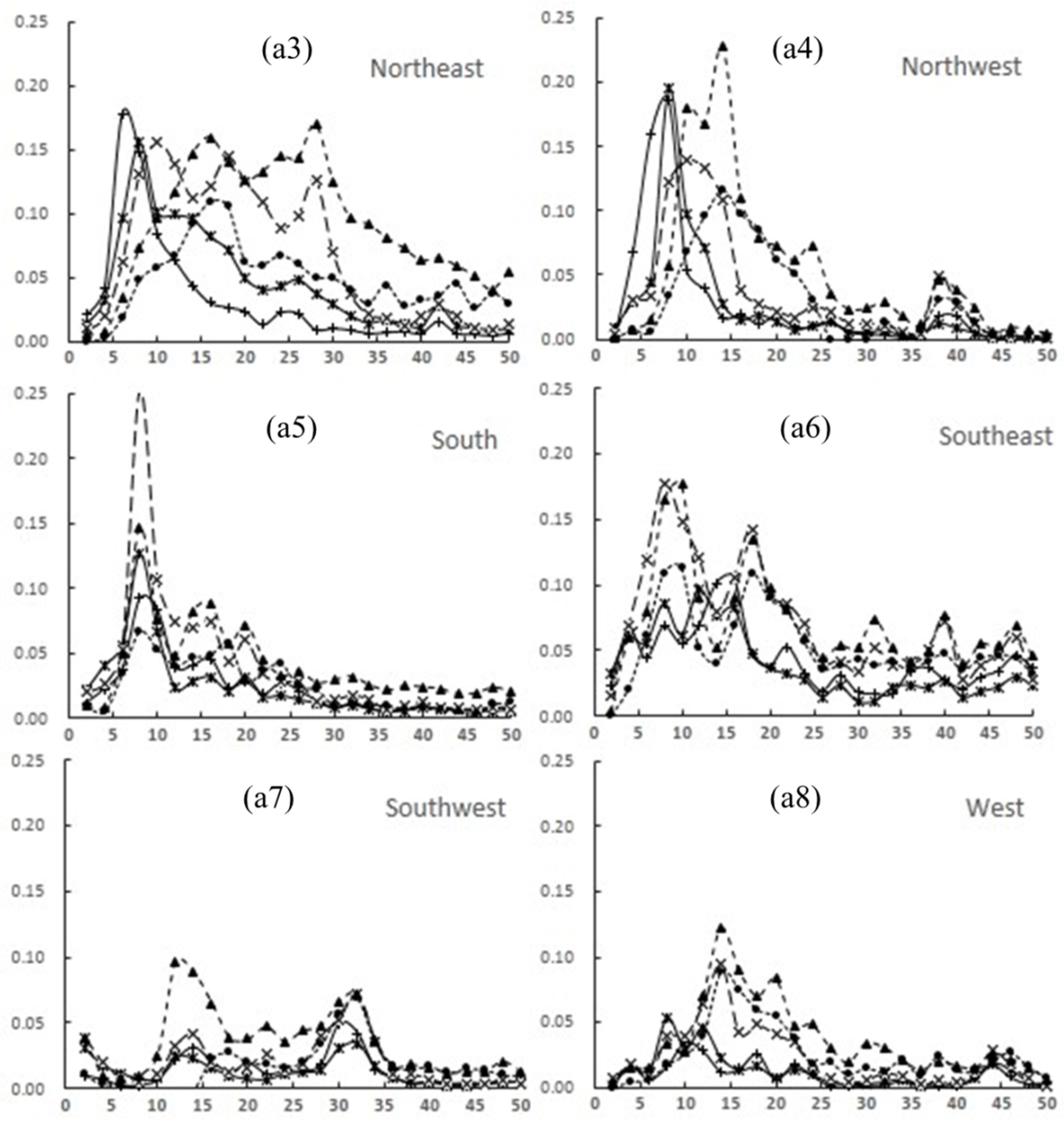
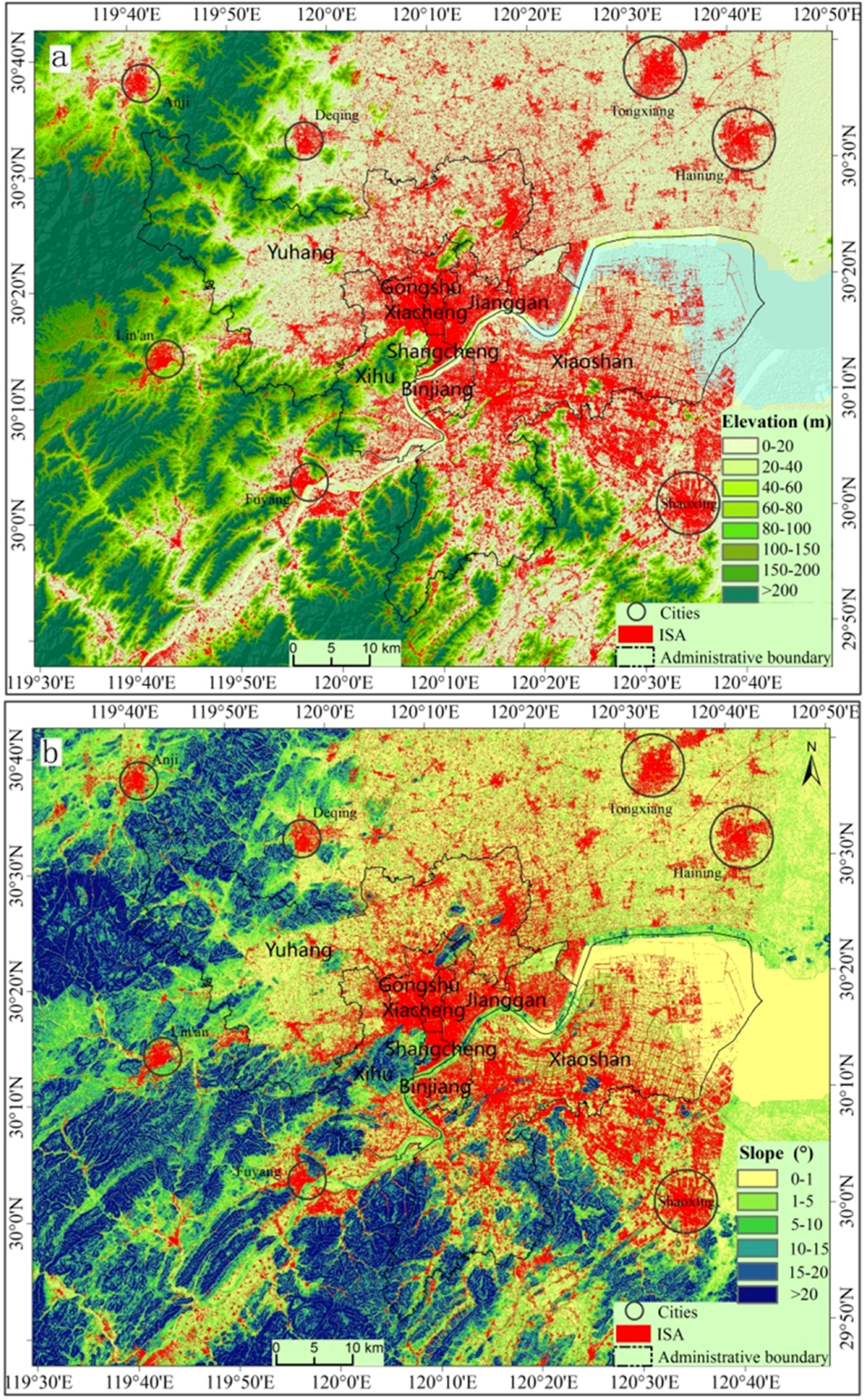
| Dataset | Image Acquisition Date | |
|---|---|---|
| Remote sensing data | Landsat 5 TM | 23 July 1991; 12 May 1994; 3 June 2005; 24 May 2010 |
| Landsat 7 ETM+ | 11 October 2000 | |
| Landsat 8 OLI | 26 October 2014 | |
| QuickBird | QuickBird images in 2010 and 2014 were used for accuracy assessment | |
| DEM | ASTER GDEM with 30-m spatial resolution | |
| Other data | Administrative boundary data at district level | |
| 2010 | 2014 | |||||||
|---|---|---|---|---|---|---|---|---|
| ISA | Non-ISA | PA | UA | ISA | Non-ISA | PA | UA | |
| ISA | 96 | 4 | 93.2 | 96.0 | 95 | 5 | 91.3 | 95.0 |
| Non-ISA | 7 | 193 | 98.0 | 96.5 | 9 | 191 | 97.4 | 95.5 |
| OA | 96.3 | 95.3 | ||||||
| 1991 | 1994 | 2000 | 2005 | 2010 | 2014 | |
|---|---|---|---|---|---|---|
| Total ISA (km2) | 145.59 | 227.69 | 321.40 | 489.55 | 733.35 | 867.63 |
| Change detection period | -- | 1991–1994 | 1994–2000 | 2000–2005 | 2005–2010 | 2010–2014 |
| Annual ISA growth rate (km2/year) | -- | 27.37 | 15.62 | 33.63 | 48.76 | 33.57 |
| 1991 | 1994 | 2000 | 2005 | 2010 | 2014 | |||||||
|---|---|---|---|---|---|---|---|---|---|---|---|---|
| km2 | % | km2 | % | km2 | % | km2 | % | km2 | % | km2 | % | |
| Elevation (m) | ||||||||||||
| <20 | 211.61 | 91.21 | 339.85 | 91.34 | 478.81 | 91.43 | 746.23 | 92.21 | 1163.96 | 92.07 | 1400.93 | 92.33 |
| 20–40 | 12.11 | 5.22 | 17.76 | 4.77 | 23.74 | 4.53 | 32.88 | 4.06 | 48.20 | 3.81 | 55.44 | 3.65 |
| 40–60 | 4.36 | 1.88 | 7.45 | 2.00 | 10.98 | 2.10 | 15.57 | 1.92 | 24.42 | 1.93 | 29.49 | 1.94 |
| 60–80 | 1.84 | 0.79 | 3.20 | 0.86 | 4.55 | 0.87 | 6.55 | 0.81 | 12.03 | 0.95 | 14.37 | 0.95 |
| 80–100 | 0.73 | 0.31 | 1.42 | 0.38 | 2.11 | 0.40 | 3.10 | 0.38 | 6.13 | 0.48 | 6.59 | 0.43 |
| >100 | 1.35 | 0.58 | 2.41 | 0.64 | 3.51 | 0.67 | 4.91 | 0.61 | 9.53 | 0.76 | 10.45 | 0.69 |
| Slope (°) | ||||||||||||
| < 5 | 217.59 | 93.79 | 364.14 | 97.86 | 511.69 | 97.71 | 790.72 | 97.71 | 1232.25 | 97.47 | 1481.57 | 97.65 |
| 5–10 | 11.44 | 4.93 | 6.33 | 1.70 | 9.28 | 1.77 | 13.87 | 1.71 | 23.11 | 1.83 | 25.77 | 1.70 |
| 10–15 | 1.98 | 0.85 | 1.48 | 0.40 | 2.48 | 0.47 | 4.16 | 0.51 | 7.85 | 0.62 | 8.71 | 0.57 |
| >15 | 0.99 | 0.42 | 0.14 | 0.04 | 0.27 | 0.05 | 0.48 | 0.06 | 1.06 | 0.08 | 1.22 | 0.08 |
© 2016 by the authors; licensee MDPI, Basel, Switzerland. This article is an open access article distributed under the terms and conditions of the Creative Commons by Attribution (CC-BY) license (http://creativecommons.org/licenses/by/4.0/).
Share and Cite
Li, L.; Lu, D.; Kuang, W. Examining Urban Impervious Surface Distribution and Its Dynamic Change in Hangzhou Metropolis. Remote Sens. 2016, 8, 265. https://doi.org/10.3390/rs8030265
Li L, Lu D, Kuang W. Examining Urban Impervious Surface Distribution and Its Dynamic Change in Hangzhou Metropolis. Remote Sensing. 2016; 8(3):265. https://doi.org/10.3390/rs8030265
Chicago/Turabian StyleLi, Longwei, Dengsheng Lu, and Wenhui Kuang. 2016. "Examining Urban Impervious Surface Distribution and Its Dynamic Change in Hangzhou Metropolis" Remote Sensing 8, no. 3: 265. https://doi.org/10.3390/rs8030265
APA StyleLi, L., Lu, D., & Kuang, W. (2016). Examining Urban Impervious Surface Distribution and Its Dynamic Change in Hangzhou Metropolis. Remote Sensing, 8(3), 265. https://doi.org/10.3390/rs8030265






